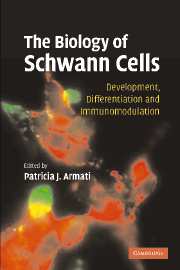Book contents
- Frontmatter
- Contents
- Preface
- Contributors
- 1 Introduction to the Schwann cell
- 2 Early events in Schwann cell development
- 3 The molecular organisation of myelinating Schwann cells
- 4 The role of the extracellular matrix in Schwann cell development and myelination
- 5 The biology of perisynaptic (terminal) Schwann cells
- 6 Cytokine and chemokine interactions with Schwann cells: the neuroimmunology of Schwann cells
- 7 Schwann cells as immunomodulatory cells
- 8 Mutations in Schwann cell genes causing inherited neuropathies
- 9 Guillain–Barré syndrome and the Schwann cell
- 10 Chronic idiopathic demyelinating polyneuropathy and Schwann cells
- References
- Index
- Plate section
2 - Early events in Schwann cell development
Published online by Cambridge University Press: 13 August 2009
- Frontmatter
- Contents
- Preface
- Contributors
- 1 Introduction to the Schwann cell
- 2 Early events in Schwann cell development
- 3 The molecular organisation of myelinating Schwann cells
- 4 The role of the extracellular matrix in Schwann cell development and myelination
- 5 The biology of perisynaptic (terminal) Schwann cells
- 6 Cytokine and chemokine interactions with Schwann cells: the neuroimmunology of Schwann cells
- 7 Schwann cells as immunomodulatory cells
- 8 Mutations in Schwann cell genes causing inherited neuropathies
- 9 Guillain–Barré syndrome and the Schwann cell
- 10 Chronic idiopathic demyelinating polyneuropathy and Schwann cells
- References
- Index
- Plate section
Summary
INTRODUCTION
The glial cells of adult peripheral nerves, myelinating and non-myelinating Schwann cells, are generated during development from neural crest cells. The protracted embryonic period of gliogenesis involves first the generation of Schwann cell precursors and subsequently the generation of immature Schwann cells. The signals controlling these early steps of gliogenesis from multipotent neural crest cells can now be analysed using transgenic and other molecular approaches, and the findings integrated with our knowledge of organogenesis of peripheral nerves. The subsequent postnatal generation of myelinating or non-myelinating Schwann cells from immature Schwann cells involves cessation of proliferation and resistance to cell death. The maturation of the nerve is likely to be regulated by a balance between signals that act as brakes to provide orderly timing for myelination and signals that actively promote it.
THE INITIAL DEVELOPMENT OF PERIPHERAL NERVES
Schwann cells originate from Schwann cell precursors, which in turn arise from multipotent neural crest cells that delaminate from the dorsal neural tube (reviewed in Jessen and Mirsky 2005a, b). The growing nerves consist initially of outgrowing axons and closely adherent Schwann cell precursors. At this stage the nerve lacks blood vessels, and there is no significant fibrous protective connective tissue around or within the nerve. Later in development, around the time that nerves establish stable contacts with their target tissues, blood vessels invade and the nerve acquires its characteristic connective tissue layers (Ziskind-Conhaim 1988; Jessen and Mirsky 2005a; Wanner et al. 2006).
- Type
- Chapter
- Information
- The Biology of Schwann CellsDevelopment, Differentiation and Immunomodulation, pp. 13 - 36Publisher: Cambridge University PressPrint publication year: 2007
- 2
- Cited by

